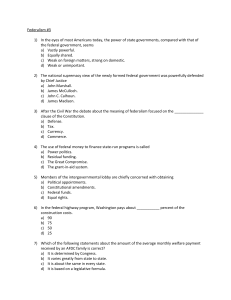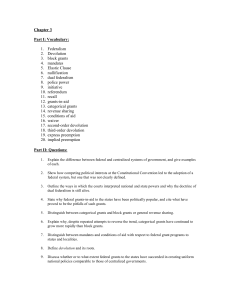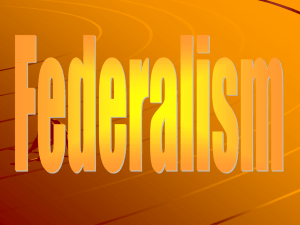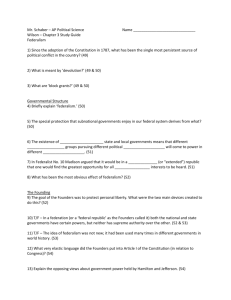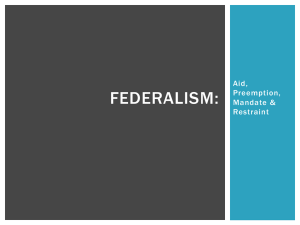Grants Power Point
advertisement
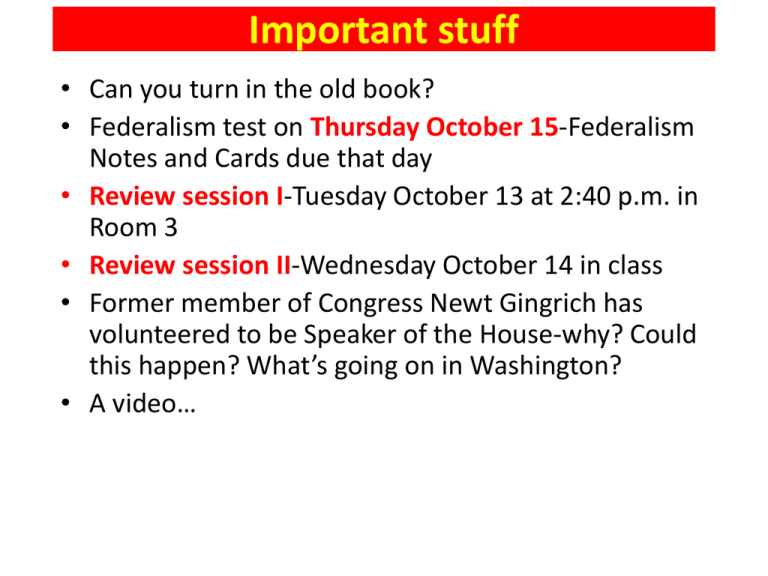
Important stuff • Can you turn in the old book? • Federalism test on Thursday October 15-Federalism Notes and Cards due that day • Review session I-Tuesday October 13 at 2:40 p.m. in Room 3 • Review session II-Wednesday October 14 in class • Former member of Congress Newt Gingrich has volunteered to be Speaker of the House-why? Could this happen? What’s going on in Washington? • A video… So, does the Congress have the power to provide health care? Grants-in-Aid • Money given to states • Allows state to use the federal revenue generating power without political costs • What’s not to love? Tombigbee Dam Some university that isn’t Carolina… Change in purpose • In the 1960’s the purposes of federal grantsin-aid change: based less on what states were demanding and more on what federal officials perceived to be national needs (urban poor, combat crime, reduce pollution, etc.) • Has led to great dependence on federal aid Intergovernmental Lobbies • Not national organizations • State and local officials for particular state or city • Purpose: Obtain more federal money with less strings attached Over the last five years, local governments in Texas have shelled out $17 million for lobbying the United States government. States receiving the most federal funding per tax dollar paid: • 1. New Mexico: $2.63 2. West Virginia: $2.57 3. Mississippi: $2.47 4. District of Columbia: $2.41 5. Hawaii: $2.38 6. Alabama: $2.03 7. Alaska: $1.93 8. Montana: $1.92 9. South Carolina: $1.92 10. Maine: $1.78 Categorical grants • A grant for a specific purposes defined by federal law (Build an airport, college dormitory) • Usually require some amount of “matching’ grant from the state or locality • A problem-could be so specific as to make it hard to adapt federal funding to local needs • A response to this problem was… Block Grants • Combine several categorical or project grant programs into a single block grant devoted to a general purpose and with fewer restrictions • Community Development Block Grants • Even block grants not as loose as… Revenue Sharing • Started 1972 (State and Local Fiscal Assistance Act) • Federal government gives funds to states and locality with no matching requirement as to matching g funds and freedom to spend the money on any governmental purpose • So, did all this stuff get lots of money with no strings to state and local governments… WELL…THE BLOCK GRANT IDEA DID NOT GROW AS MUCH AS EXPECTED-FOR TWO REASONS… First-Congressional reluctance • The amount of money did not grow as much as some hoped and not as much as categorical grants-why? – “Strings” increased-more categorical, less block • What accounts for “strings”—well, categorical grants are supported by Congress and federal bureaucracy because of increased federal control over the money’s use • So, whenever Congress wanted to address the problem their default was categorical because that means they decide how it would be spent. And in the face of the “federal” default-it is hard for state and locals to make a good case for block grants • Because block grants and revenue sharing cover such a broad range of activities no single interest group has a vital interest in pressing for their enlargement – Example-revenue sharing provides some of the budget for lots of different agencies, but not the whole budget for any one-so expansion of revenue sharing not life an death for anyone • By contrast categorical grants are life and death for various agencies (ex. Highway department) – Categorical grants are overseen by special committees of Congress-who have an interest in saying them expand Rivalry among states--Snowbelt v. Sunbelt • Formulas can be written into federal laws by which block grants are allocated – A slight change in formula can result in shift of millions of dollars from frost to sun • With the advent of grants based on formulas (as opposed to a project) there is more importance on the census-lose people lose money • Struggle over allocation formulas-slight changes result in big dollar implications • Some make sense-some don’t-the new York/Grand Rapids public transportation mass transit grant for example Federal Aid and Federal Control • So, too much federal control? • Increased block and revenue sharing over the past decades? No, categorical grants continued to grow (why?) • How else does the federal government control states? • 2 ways- (1) Mandates • Federal government directly orders the state government to take specific actions • Some related to money they take • Some not – Most of these concern civil rights (may not discriminate) or – the environment (clean air, water, etc.) Form of mandates • Often regulatory-and – Some expand previous legislation (1982 Voting Rights Amendments) – Some deal with new areas (1986 Handicapped children’s Act) – Some are easy to understand (Ocean Dumping Ban) – Some are harder to interpret/administer (Americans With Disabilities Act) Other ways to mandate costs on states • Federal Tax or regulatory policies that limit the way states raise revenue, borrow funds, or privatize public functions • Federal Courts – State prison plan, desegregation plans, etc. – Actions under the civil rights acts (2) Conditions of Aid • Theoretically voluntary (if you don’t want the strings don’t take the money) – If you build something with federal money you must conduct an EIS, pay the workers “prevailing wage”, etc. • So, in the 60’s it seemed like free money • What happens is that the laws federal officials pass are intended to address national constituencies-they end up leaving states and localities to manage the problems • Notice both sides trying to address different constituencies, address problems, and pass the costs on to the other side Reagan Revolution • Attempt to change categorical grants to block grants-less money and less strings • Was it wholly successful? – Congress went along to some extent – In the 80’s state and local governments did more with less (aided by economic groth) – Then… Devolution Revolution • Let’s shift things back to the states! Give states federal functions • Clinton “era of big government is over” • Welfare– AFDC – Clinton-Personal Responsibility and Work Opportunity Act ended federal guarantee of support – Turned management of program over to the states aided by federal block grants “Welfare” and Medicaid • 2 biggest grant-in-aid programs – Not originally created as block grant programs – Both were operated as entitlement programs-each state entitled to money based on how much it spent to help the targeted group – Each state determined the levels of benefits they wanted to give out (within a framework of federal law and regulation) So what happened to “welfare” and health care in the Devolution Era • AFDC ended • Replaced by block grant program Temporary Assistance for Needy Families (TANF) • Medicaid and other larger programs NOT turned into a block grant programs • State and federal spending on grants increased • TANF the exception that proves the rule (no widespread movement to blocks) Effects of “Devolution” • More, not fewer, government regulations (because states are now in the game too) • Where it did occur (welfare)—consequences – Welfare rolls decrease (why?) – Lots of local governments are implementing welfare programs through “for profits” and “nonprofits” What’s driving devolution • Ideology of elites • Realities of deficit politics • Views of citizens Congress and Federalism • Members of Congress don’t always represent states-they often represent interests in states-and different interests like different mixes of federalism • Party controls on these individual assessments of interests have eroded-so a large number of different perspectives are represented • Ideologically we differ on which level of government is most effective in addressing an issue Let’s play… Your job (whether or not you choose to accept it…) • Find someone from the other side • Shake hands and agree to bargain in good faith for “the sake of the children” • Reach an agreement regarding the manner in which the United Sates government should provide assistance to states for education…You can include whatever makes sense to you both, including , but not limited to: – – – – – Categorical grants Block grants Mandates Conditions of Aid Others? • You must memorialize you agreement in a Memorandum of Understanding signed by both sides. • Good luck!
